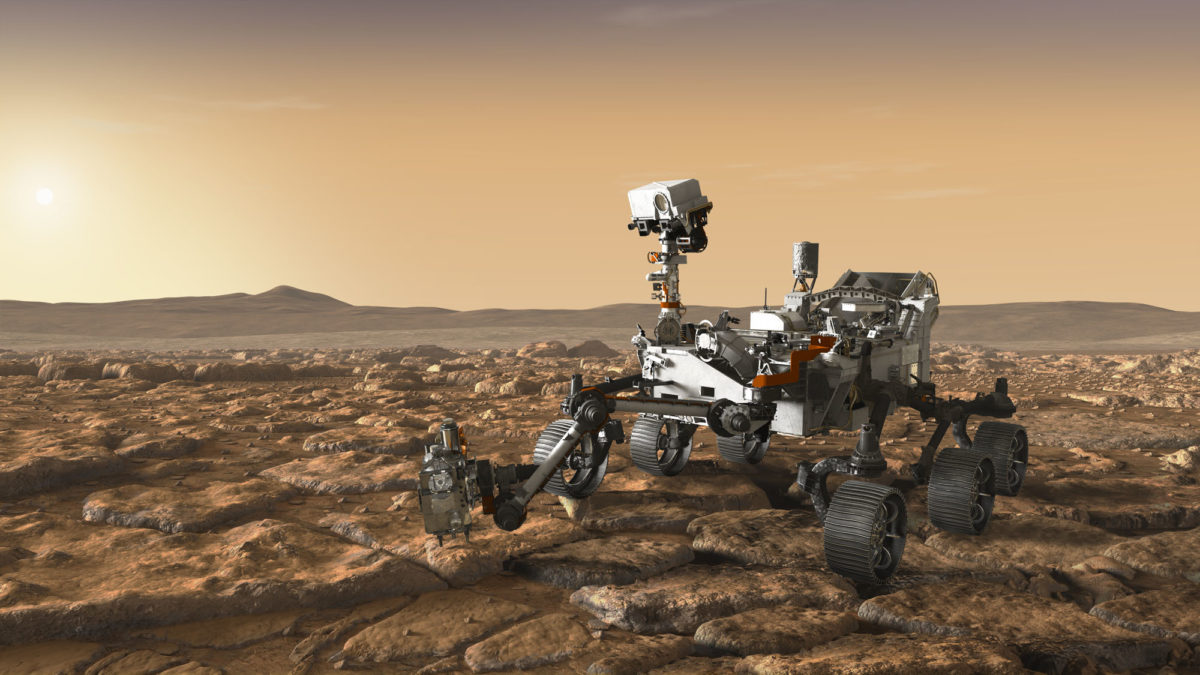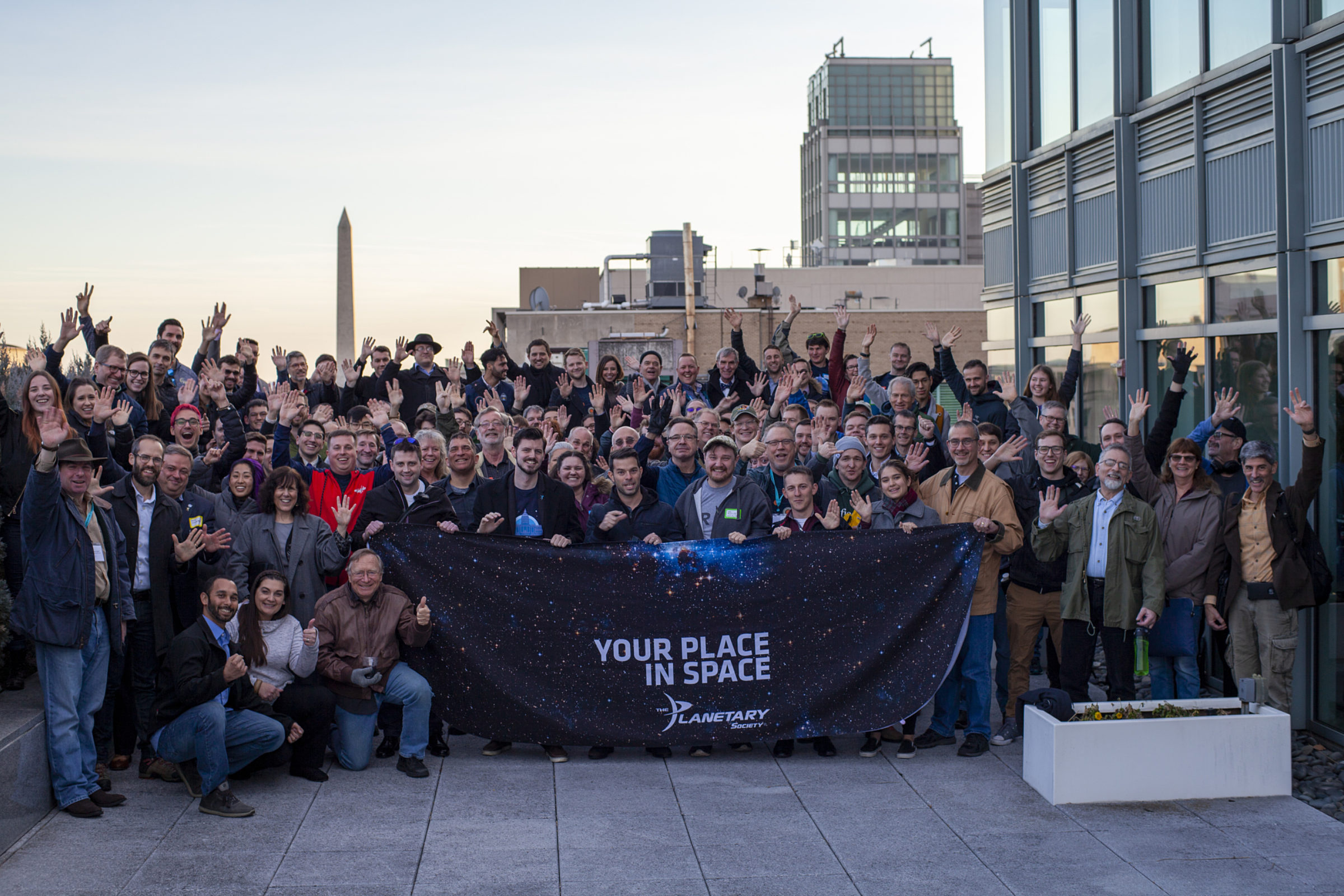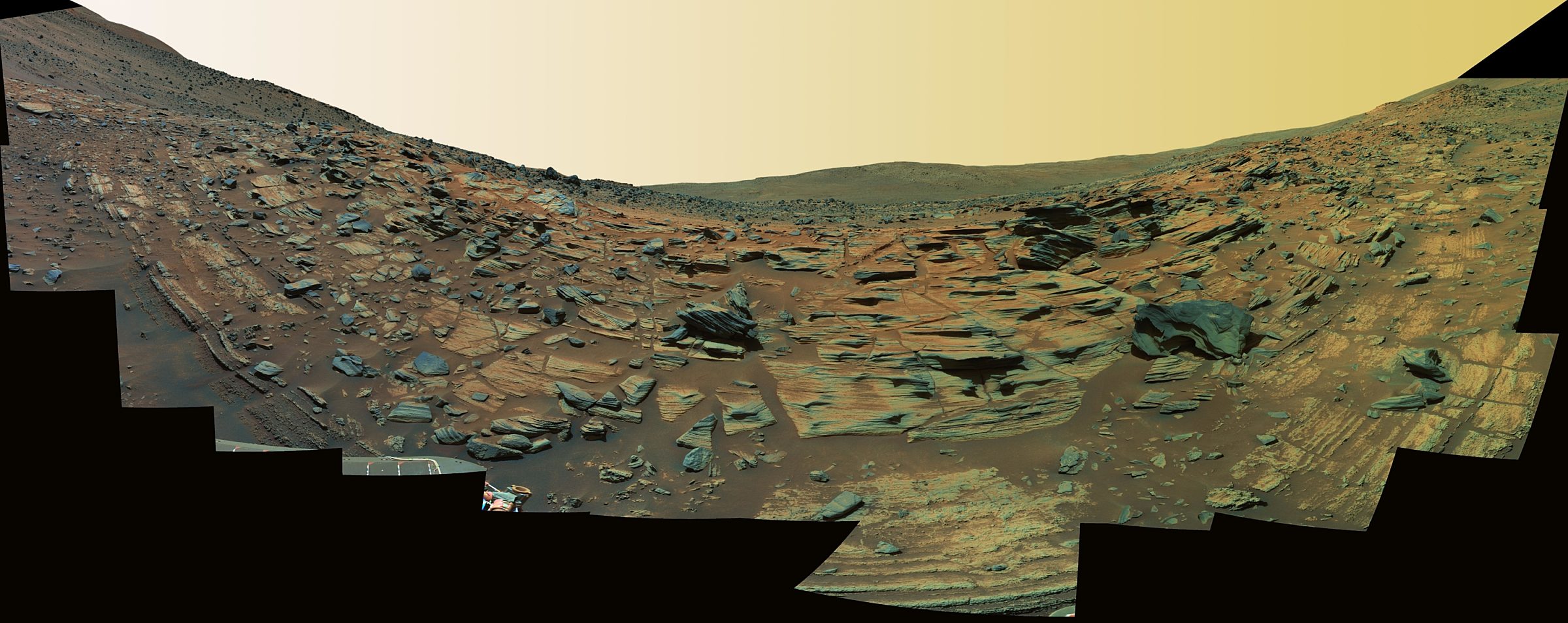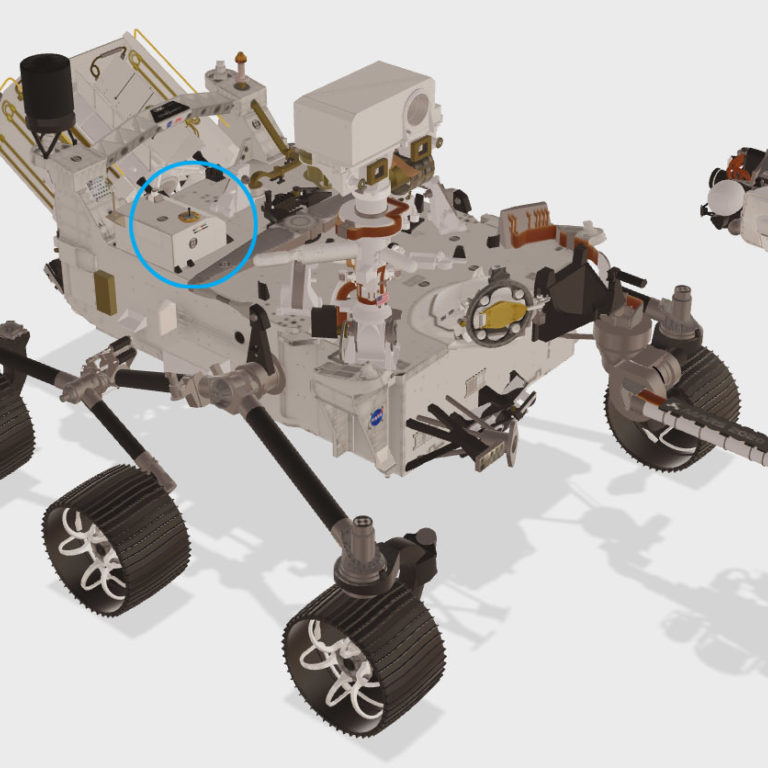
On the Cover: A SpaceX Crew Dragon capsule carrying astronauts Robert Behnken and Douglas Hurley nears splashdown in the Gulf of Mexico off the coast of Pensacola, Florida on 2 August 2020. Behnken and Hurley spent 64 days in space as part of the first crewed commercial flight to the International Space Station. Credit: NASA/Bill Ingalls
Download PDF
Features
December Solstice 2020
Your Impact: December Solstice 2020
We're celebrating a congressional nod, PlanetVac's upcoming trip to the Moon and Mars, and more.
The Year 2020 in Pictures
These pictures helped us find hope and perseverance during a tough year on planet Earth.
Calibrating Mars
Two colorful calibration targets will help scientists measure what the Perseverance rover sees on Mars.
Space on Earth
Countdown to Liftoff

When NASA announced the name of the James Webb Space Telescope in 2002, the observatory was scheduled to launch in 2010. While it’s common for one-of-a-kind space projects involving new technologies to run over budget and fall behind schedule, not many people would have predicted that Webb would still be on the ground at the end of 2020 with a price tag that has grown to almost $9 billion, not including operations costs.
If all goes well, 2021 will be Webb’s year. The flagship observatory is currently scheduled to blast off on 31 October 2021 after its latest delay of 7 months caused in part by COVID-19. This image shows technicians folding the telescope for launch configuration prior to sound and vibration tests. To learn more about the telescope, visit planetary.org/webb.
Snapshots From Space
Hello, Venus

Three months ago, scientists using Earth-based telescopes announced they had found phosphine in Venus’ clouds. Phosphine is a molecule strongly associated with life that has few nonlife methods of production, particularly on a rocky planet like Venus. Some regions of Venus’ upper atmosphere are remarkably temperate and Earthlike, and for decades, scientists have hypothesized that there could be microbial life-forms floating around the planet. As of early November, other scientists have not been able to replicate the results or detect the phosphine using other instruments. Extraordinary claims require extraordinary evidence—evidence that future Venus missions could collect.
This picture of Venus comes from Europe and Japan’s BepiColombo spacecraft, which is on its way to Mercury. On 16 October 2020, BepiColombo performed the first of 2 Venus flybys using the planet’s gravity to bend its trajectory toward Mercury. Venus appears here as a featureless bright orb, much as it would look to a human peering out a spacecraft window.
Your Place in Space
A Picture Is Worth a Thousand Words: Seeing for Ourselves What's Out There and What's Right Here
By Bill Nye, Planetary Society CEO
As I hope you know, it’s family lore here at The Planetary Society that a big reason humankind has images from interplanetary spacecraft is because our cofounder Bruce Murray insisted that the fleet of Mariner spacecraft that flew to Mercury, Venus, and Mars have cameras on board. By all accounts, there were a great many scientists in the 1960s who insisted that images would be a luxury, a publicity ploy, and of limited scientific value. Can you imagine a planetary exploration program without pictures?
This issue of The Planetary Report looks at some of the most impactful space images from the past year. Along with everything that we learn about the worlds in our cosmic neighborhood, pictures can make the story come to life. When we look at a photo of Venus shrouded in thick clouds, it makes the excitement of possible biosignatures in that atmosphere all the more real.
I bring this up, of course, because along with a great many of you, I live with the hope that we will find evidence of life—or even something alive—right here in our own solar system. Well, my friends, diligent researchers have discovered what may be phosphine gas in the atmosphere of Venus. Other scientists have already examined and questioned those results, and we’ll have to be patient while the scientific process examines these extraordinary findings.
But no matter what happens, consider the possibility: right now, unless you have an environment with Jovian gas-giant pressures, we don’t know of any way to produce a measurable abundance of phosphine without something like anaerobic (no-oxygen) bacteria metabolizing away, replenishing this gas as it breaks down in sunlight. If you haven’t stopped to think this over, please do so now.
Although the surface of Venus is inhospitable—I mean hellish in the literal sense—55 kilometers (34 miles) above the surface, the nominally toxic gasses of the atmosphere are a temperate 30 degrees Celsius (86 degrees Fahrenheit). Could something live up there? Could it be that Venus had liquid water oceans and more Earthlike air in primordial times, which led to life, and because of a runaway greenhouse effect, all that’s detectable there today are the exhalations of some kind of aeroplankton—very small anaerobes drifting high in the Venusian sky? That would be ... well, that would be amazing. It would change the course of human history. It might quickly lead to an answer to the deep question “how did life begin?” or perhaps “how does life begin there, here, or anywhere?”
While you’re thinking about all that, please take some time to look at the pictures we’ve chosen for this issue. They’re from space—and so are we. The more we learn about the cosmos and our place within it, the more we realize the significance of our own world and how perfectly suited our species is to this place. Astronauts often speak of the overview effect. By their accounts, once you see Earth from space, you’re never the same. Carl Sagan brought this sentiment home with his powerful few paragraphs about the pale blue dot. Seeing our home world in an image snapped from the cold emptiness of space reminds us to treasure what we have right here beneath our feet. It seems as though there’s a great deal of trouble for our species these days, but with the powerful understanding of our place among the stars, we can work together to make our world wonderful while we explore what else must be out there.
Get Involved
The Return of Planetfest

In February 2021, the next generation of Mars exploration will begin. With the United States of America’s Perseverance rover, China’s Tianwen-1 lander, and the United Arab Emirates’ Hope orbiter all arriving at the Red Planet, this calls for a global celebration.
Planetfest ‘21 will continue The Planetary Society’s long-standing tradition of ringing in a major exploration milestone by hosting a festival to bring together the people who love exploration and the ones who make it happen. The festivities will culminate with a worldwide virtual landing party marking Perseverance’s arrival on the Red Planet.
This time, with the coronavirus pandemic still preventing in-person gatherings, we will get together virtually. The silver lining, of course, is that people from around the world can join the festivities. So, wherever you are, we invite you to join us in February to usher in this exciting new age of Mars exploration.
Keep an eye on your email inbox for announcements from us about this exciting virtual event and go to planetary.org/planetfest21 to learn more.
You're Cordially Invited...
Members, save the date for a virtual gala like no other. During Planetfest ’21, we invite you to join us for an exclusive virtual dinner event with our CEO Bill Nye, members of our board of directors, and other space luminaries. We look forward to celebrating our 40 years of shared achievement with you.
New 2021 Member Directory
The Planetary Society is partnering with Publishing Concepts, Inc. to offer members—that’s you!—the opportunity to reserve a digital or hardbound 2021 Planetary Society Member Directory. Starting in early 2021, postcards and emails will be sent out to give you the chance to opt in for this opportunity, update your contact information, and reserve your copy.
This special-edition directory will document our organization’s 40-year history and be filled with photos and stories from over the years. Plus, it will contain a listing that will help you stay connected with fellow members. We hope you’ll participate and reserve your copy!
Important Tax Deadlines
For U.S. tax purposes, gifts must be received on or before the last day of the year. Here are some common methods of making a gift and the associated deadlines.
ONLINE CREDIT CARD GIFTS: transaction completed by 11:59 p.m. EST (8:59 p.m. PST), 31 December
CHECKS SENT VIA U.S. MAIL: postmarked on or before 31 December
CHECKS SENT VIA THIRD-PARTY SHIPPING (SUCH AS FEDEX OR UPS): delivered on or before 31 December
CREDIT CARD GIFTS VIA U.S. MAIL: received and processed on or before 31 December
STOCK TRANSFER: broker-to-broker instructions issued in time for completed transfer on or before 31 December
Join the 2021 Day of Action

The Day of Action is an annual event that brings together Planetary Society members and their representatives in Congress. In-person congressional meetings are not possible at present, so we’re organizing our first-ever virtual Day of Action for the spring of 2021. We’ll arrange virtual meetings with your congressional representatives and their staff so you can safely and effectively share your passion for space science and exploration. Non-U.S. residents will have ways to participate as well. Learn more and register at planetary.org/dayofaction.
“Until my first Day of Action, I always thought of the government as Them. Now I think of it as Us.” — Laurel B., 2019 Day of Action Participant, United States
Keep Looking Up! You Make This Work Possible
This has been a year like no other. We have been challenged, we have changed, and we have grown. Space science and exploration—and the benefits they provide to humankind—are even more vital to our dream of a positive future. As 2020 comes to an end, your support will ensure that we can continue to advance space science and exploration in 2021 and beyond. You can fuel our advocacy, education, and science and technology work while going through whatever challenges our world faces in the coming years. Go to planetary.org/planetaryfund to do your part to support the future of exploration and discovery and to help spread the cosmic perspective to people all around Earth.
What's Up?
In the Sky
By Bruce Betts, Planetary Society Chief Scientist
On 21 December 2020, very bright Jupiter and yellowish Saturn will be closer in the sky than they have appeared in almost 400 years. Low in the west in the early evening, they will be 7 arcminutes apart, or less than one-fourth the width of a full Moon. They will remain relatively close as they drop out of view below the horizon over the following weeks. They will reappear in the predawn east by March. Reddish Mars is in the evening south. Super-bright Venus is visible in the predawn east in January but then moves out of the night sky. Mercury is low in the west in the evening in late January and is then close to Jupiter and Saturn very low in the predawn east at the beginning of March. The Quadrantids meteor shower peaks the night of 2–3 January. The Quadrantids is an above-average shower, but the Moon will interfere some with visibility this year.
Random Space Fact
The atmospheric surface pressure on Venus is higher than the bite pressure of a grizzly bear.
Trivia Contest
Our June solstice contest winner is Guy Horanberg of Santa Clarita, California, USA. Congratulations! The question was: What was the first successful robotic mission to return samples from beyond Earth? The answer: The robotic Soviet Luna 16 mission returned 101 grams (3.6 ounces) of samples from the Moon in 1970.
Try to win a copy of Space Exploration for Kids by Bruce Betts and a Planetary Radio T-shirt by answering this question:
What was the only Apollo spacecraft call sign named after a single star?
Email your answer to [email protected] or mail your answer to The Planetary Report, 60 S. Los Robles Ave., Pasadena, CA 91101. Make sure you include the answer and your name, mailing address, and email address (if you have one). By entering this contest, you are authorizing The Planetary Report to publish your name and hometown. Submissions must be received by 1 March 2021. The winner will be chosen in a random drawing from among all the correct entries received.
For a weekly dose of “What’s Up?” complete with humor, a weekly trivia contest, and a range of significant space and science-fiction guests, listen to Planetary Radio at planetary.org/radio.
Where We Are
An At-a-Glance Spacecraft Locator

The flotilla of spacecraft launched to Mars in July has almost arrived. On 18 February 2021, NASA’s Perseverance rover will plunge through the Martian atmosphere in a dramatic repeat of the 2012 Curiosity landing. Also in February, the United Arab Emirates’ Hope mission will aerobrake into Martian orbit to begin studying the planet’s climate, while China’s Tianwen-1 orbiter and rover will enter orbit before the rover descends to the surface around May.
Japan’s Hayabusa2 spacecraft should have delivered its precious samples of asteroid Ryugu to Earth on 6 December 2020 and is now starting its extended mission to visit 2 more asteroids. Europe and Japan’s BepiColombo spacecraft flew past Venus on 16 October and will make a second flyby in August 2021. NASA’s OSIRIS-REx, fresh off its successful sample collection at asteroid Bennu, is expected to depart for Earth in March 2021.
Learn about all 3 new Mars missions at planetary.org/mars2020.
To stay up to date on these and other missions, visit planetary.org/space-missions.
To get weekly mission news in your email inbox, visit planetary.org/connect.
Why I Explore
The Inspiring Artistry of Space

I was sitting in Dr. Ray Arvidson’s clean white computer lab, staring at a wall-sized panoramic image of Home Plate, a rough whitish outcrop in Mars’ Columbia Hills. At the time, I was an art student, and my latest assignment was to draw a 6-by-4-foot charcoal self-portrait with a focus on chiaroscuro—light and shadow. For reference, my art professor showed us paintings by Caravaggio and stills from Orson Welles’ Touch of Evil, but I never thought that I would find such an interesting example here in Ray’s Land Use and the Environment class. The bright, reflective rock faces contrasted with the inky shadows underneath the jutting rock layers, all nestled in gently sloping hills against a dim orange sky—a portrait of stark beauty. My jaw dropped in complete awe; I was astounded by the incredible power of one image.
After that first class, I discovered that pictures—like an outcrop at Home Plate or a CRISM image colored by different spectral bands—could lead to questions. Of what is this made? How do clays form on Mars? My undergraduate research thesis tackled the latter question, tying together multispectral imagery of Nilli Fossae from CRISM with visible/near infrared spectroscopy and analytical chemistry techniques. The artistry of Mars and, during my graduate studies, the eerie beauty of Titan never failed to astonish me, and every downlinked image started a new round of “what is this, and how can we figure it out?”
As we eagerly await the arrival of 3 new Mars missions, a massive space telescope, and a quadcopter on Titan, I wonder what our pictures will inspire. What questions will we ask, and how will we solve them? When we’re left grasping for answers, what will we explore next?
— Bryné Hadnott is a Planetary Society member, researcher, and writer currently based in Seattle, Washington. When she’s not coding image-processing algorithms in Python, she’s writing creative nonfiction essays in her terrible handwriting or finding secret places to paddleboard. She likes coffee, loves dogs, and isn’t a fan of cilantro.
Planetary Society members are explorers. We share this common passion, although we have different stories that drive our passion. We’re curious to know your story. If you’d like to share, we’ve set up a form at planetary.org/whyexplore, where you will also be able to read other “Why I Explore” stories. We’ll also continue to share stories in future issues of The Planetary Report.
Astronomical Art
Enceladus Ice Fields by Fraser Hagan

Saturn’s moon Enceladus is an icy world whose surface is ever-changing. A subsurface ocean of liquid water creates tectonic activity on its surface, causing water to spew from geysers and marking the surface with a mosaic of fractures, ridges, and valleys. When Enceladus was named in 1789, its tectonic qualities were not yet known; it simply appeared as a point of light orbiting the planet Saturn. The moon’s name turned out to be surprisingly fitting. Enceladus is named after a giant from Greek mythology. The giant Enceladus was said to cause earthquakes and volcanic eruptions on Earth as he shifted beneath the ground. We now know that these phenomena are caused by Earth’s own tectonic activity. Although the great icy fissures of Enceladus are not caused by the movements of a giant beneath its surface, what lies beneath the ice is no less intriguing. Enceladus’ subsurface oceans are one of the places in our solar system most likely to hold some form of life.
— Fraser Hagan is a graphic designer from Vancouver, Canada and a member of The Planetary Society.
Do you want to see your artwork here? We love to feature our members throughout this magazine. Send your original, space-related artwork to [email protected].
The Planetary Report • December Solstice 2020
Help advance space science and exploration! Become a member of The Planetary Society and you'll receive the full PDF and print versions of The Planetary Report.


 Explore Worlds
Explore Worlds Find Life
Find Life Defend Earth
Defend Earth




